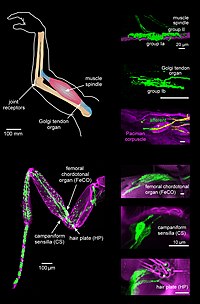
Photo from wikipedia
Objective Human gait requires complex somatosensory processing of various inputs such as proprioception. Proprioception can be altered in the presence of pain. This has been shown mostly during controlled tasks,… Click to show full abstract
Objective Human gait requires complex somatosensory processing of various inputs such as proprioception. Proprioception can be altered in the presence of pain. This has been shown mostly during controlled tasks, thereby limiting the influence of external perturbations. While controlling the environment is sometimes warranted, it limits the ecological validity of the data. Using robotic orthoses to apply perturbations during movements seems a promising tool to functionally assess proprioception, where the complex somatosensory processing required in real-life situations is at play. The main objective of this study was to compare the proprioceptive threshold of healthy participants during gait in the presence and absence of an acute experimental pain. Methods 36 healthy participants walked on a treadmill while wearing a robotized ankle–foot orthosis (rAFO) around their right ankle. The rAFO applied torque perturbations of graded magnitudes during the swing phase of gait. Participants had to report the presence/absence of such perturbations, as a measure of proprioceptive threshold. Following initial assessment, they were randomly assigned to one of three experimental groups: Control (no stimulation), Painless (non-nociceptive stimulation) and Painful (nociceptive stimulation). Electrodes placed on the right lateral malleolus delivered an electrical stimulation during the second assessment for Painless and Painful groups. A Kruskal-Wallis was used to compare the percentage of change of the three groups between the two assessments. Results A 31.80±32.94% increase in proprioceptive threshold, representing an increase of 1.3±1.2 Nm in the detection threshold, was observed for the Painful group only (p<0.005), with an effect size of 1.6. Conclusion Findings show that the presence of pain at the ankle can alter participants’ proprioceptive threshold during gait. Clinical assessment of proprioception should therefore carefully consider the presence of pain when evaluating a patient’s performance using clinical proprioceptive test and consider the negative effect of pain on proprioceptive threshold for test interpretation.
Journal Title: PLoS ONE
Year Published: 2022
Link to full text (if available)
Share on Social Media: Sign Up to like & get
recommendations!